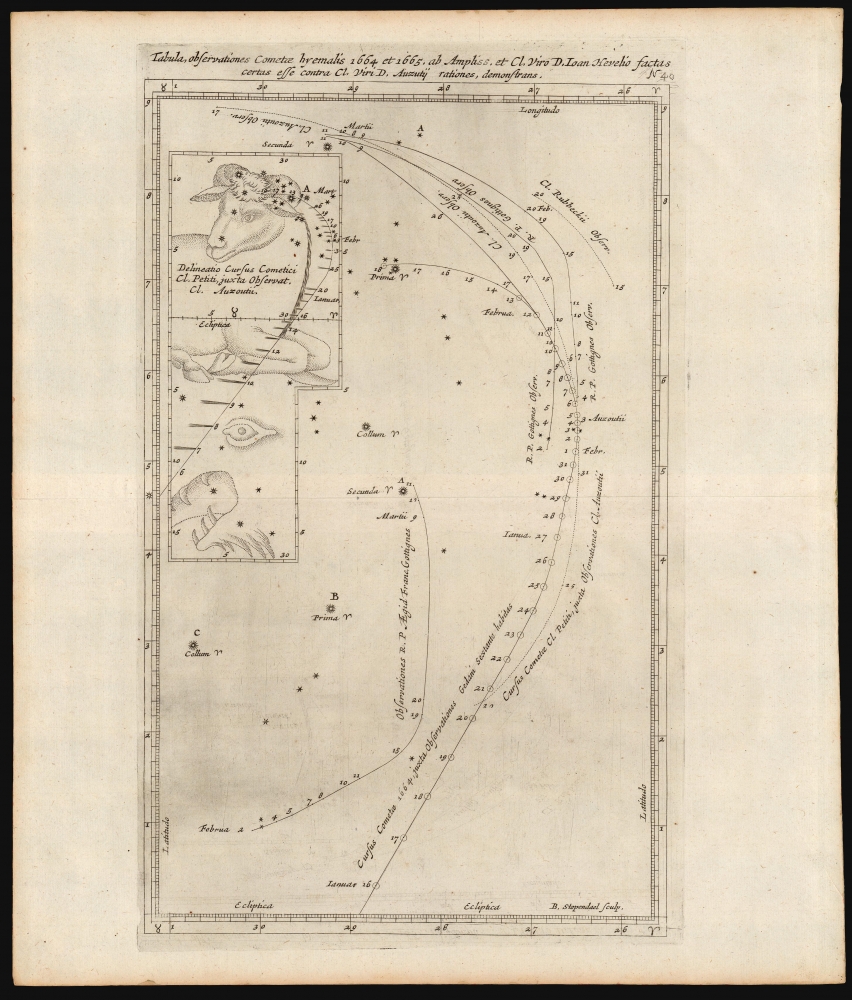1668 Lubieniecki Chart Depicting the Movement of Comets
Comets-lubieniecki-1668$1,800.00

Title
Tabula, observationes Cometae hyemalis 1664 et 1665, ab Ampliss. et Cl. Viro D. Ioan Hevelio factas certas esse contra C. Viri D. Auzutii rationes, demonstrans.
1668 (undated) 13.5 x 8 in (34.29 x 20.32 cm)
1668 (undated) 13.5 x 8 in (34.29 x 20.32 cm)
Description
This elegant and important 1668 celestial chart depicts the motions of comets observed in 1664 and 1665. The sheet was included in the first volume of Stanislaw Lubieniecki's Theatrum Cometicum, which expounded on the history of observed comets beginning from those mentioned in the Bible and including the detailed accounts of the comets observed by himself, and the European scientific community, in 1664 and 1665. This chart - A table of observations of the winter comets of 1664 and 1665, by the most eminent and distinguished man, D. Joan Hevelius, showing that they were certain against the accounts of the most distinguished man, Auzutij. - captures what was then an international scientific controversy between the Polish astronomer Johann Hevelius (1611 - 1687) and the French astronomer Adrien Auzout (1622 - 1691).
Entering the scholarly arena, Frenchman Adrien Auzout published his predictions of the movements of the comets of 1664 and 1665 based on his hypothesis that comets moved in large, circular orbits; he appealed to the scientific community to provide observations to either support or refute his predictions. Gdansk's Hevelius correctly concluded that his observations of the comet disproved Auzout's hypothesized circular orbit. Unfortunately, Hevelius' own published observations contained errors in the position of the comet, which Auzout singled out to discredit the whole of Hevelius' critique. Many scholars joined Auzout in harping on the issue of one erroneous observation rather than Hevelius' attempts to validate a hypothesis of comets' parabolic orbits. The present sheet summarizes Hevelius' response, which was to compare Auzout's predictions not only with his own observation but also those of French scholar Pierre Petit (1630 - 1677,) the Jesuit Francois Gottignies (1630 - 1689) and Swedish scientist Olof Rudbeck (1630 - 1702). Hevelius thus established that his observations were consistent with those of other European scholars and gave authority to the idea of comets' parabolic motion.
A Closer Look
This chart, engraved in Amsterdam by Daniel Stoopendaal, delineates seven separate scholars' tracks of a 1664 comet observed between January and March of that year. The tracks are marked with the dates of observation. Stars are included to show the comets' position in the night sky. An inset shows the comet's track in conjunction with the constellation Aries, which is depicted pictorially as a lamb.The Hevelius-Azout Controversy
Lubieniecki's celestial captures the efforts of astronomer Johann Hevelius to overcome a controversy that had erupted between him and the French mathematician and astronomer Adrien Azout. The nature and movement of comets were not yet understood in the 17th century - many still agreed with Kepler that comets moved in a straight line. There were insufficient accurate observations, and scholars had yet to establish any theory with which to digest new ones.Entering the scholarly arena, Frenchman Adrien Auzout published his predictions of the movements of the comets of 1664 and 1665 based on his hypothesis that comets moved in large, circular orbits; he appealed to the scientific community to provide observations to either support or refute his predictions. Gdansk's Hevelius correctly concluded that his observations of the comet disproved Auzout's hypothesized circular orbit. Unfortunately, Hevelius' own published observations contained errors in the position of the comet, which Auzout singled out to discredit the whole of Hevelius' critique. Many scholars joined Auzout in harping on the issue of one erroneous observation rather than Hevelius' attempts to validate a hypothesis of comets' parabolic orbits. The present sheet summarizes Hevelius' response, which was to compare Auzout's predictions not only with his own observation but also those of French scholar Pierre Petit (1630 - 1677,) the Jesuit Francois Gottignies (1630 - 1689) and Swedish scientist Olof Rudbeck (1630 - 1702). Hevelius thus established that his observations were consistent with those of other European scholars and gave authority to the idea of comets' parabolic motion.
Publication History and Census
This sheet was engraved in 1668 by Daniel Stoopendaal for inclusion in Stanislaw Lubieniecki's Theatrum Cometicum. The book is reasonably well represented in institutional collections, but we see no separate examples of Stoopendaal's engraving in OCLC or in the trade.Source
Lubieniecki, Stanislaw, Theatrum Cometicum, Duabus Partibus Constans, (Amsterdam) 1668.
Condition
Very good; tiny wormhole not impacting printed image, else excellent.

